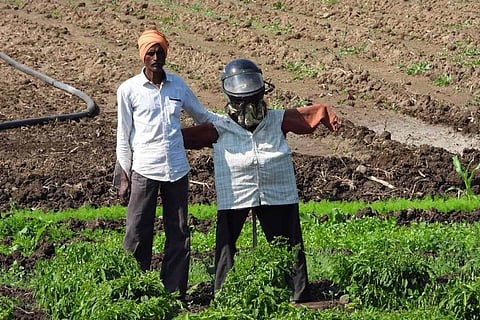

“As you sow, so shall you reap,” they say. Farmers in any hilly forested area in the country, however, are likely to beg to differ, the tribal belt in the north of Telangana state being a case in point. When it comes to reaping harvest around this time of the year, it is often the proverbial slip between the cup and the lip for tribal farmers. Wild boars and monkeys to parakeets and pigeons, the creatures of the wild often descend upon their standing crops across thousands of acres, pillaging and plundering. In fact, the average crop loss in hilly forest areas such as the agency tracts of Adilabad and Komaram Bheem Asifabad districts, which along with Mancherial and Nirmal districts earlier constituted the united Adilabad, is put at a high of 40%.
Farmers have been losing their crops to marauding wildlife since time immemorial, and it has nudged them into using their creativity to devise non-violent means of crop protection. Among them is the erection of scarecrows on their fields, out of the belief that these figures resembling humans will help them outwit birds and wild animals, by making it look like it is the farmer who is guarding their field.
The scarecrow method of crop protection is a demonstration of the tribal farmers’ sense of coexistence. Though they try their best not to lose their crops, rarely do they rue over the loss if the wildlife devours some of their food grains to survive. “We have been dealing with this problem forever,” said a relaxed Kova Lacchu, a Raj Gond farmer from the hilly Modiguda in Tiryani mandal of Komaram Bheem Asifabad district. “But scarecrows have definitely helped us save our crops to some extent,” he added, as he cast a stone from a slingshot towards the hungry birds trying to settle on his jowar (sorghum crop).


Over the years, scarecrow making has also evolved into an avenue for the farmers to showcase their creativity. The figures are often contemporary, embodying the current trend in the given area during a given year. At times, they take on more poignant and thought-provoking forms, reflecting the time in which it was made and the even more persistent problems of that period. For instance, towards the end of the 2020 kharif season, farmer Rupender Naik, of Arepalli at Mamda mandal in Nirmal district, had built a scarecrow wearing a white raincoat that resembled a PPE kit. The appearance of doctors and other health staff during the COVID-19 pandemic, the images of which were omnipresent at the time, had apparently caught the farmer's imagination.

In 2014, the image of a scarecrow hanging with a rope around its neck on the cotton fields of Athram Ramu, near Dhanora of Kerameri mandal in Asifabad, had presented a grim picture. The figure had appeared at a time when suicides by cotton farmers were being reported almost every day in the region.

Structurally, scarecrows are usually made of discarded clothes and other objects. An out-of-use umbrella, placed on top of the scarecrow as if it is being held by a farmer, or an earthen pot propped up as the head are common sights on farming fields.



The agricultural season of 2011 had seen farmers earning handsome profits. The very next year, a tribal farmer from Rasimetta in Asifabad came up with the idea of a happy scarecrow couple headed towards the weekly shandy, evidently expecting the season at hand to be at least equally profitable.

The farmers’ politics too, which often materialises in the form of skits during the Adivasi people’s Dandari festival, now reflects on their scarecrows as well. In August last year, the Congress party in Telangana had organised a public meeting in Indervelly mandal of Adilabad district, which prompted a Raj Gond farmer to build a scarecrow carrying a party flag, evoking the image of a party worker.

Even the strict implementation of traffic rules seems to have stirred the imagination of farmers, as was seen in the years 2019 and 2020. Scarecrows in many fields resembled motorcyclists wearing helmets, never mind the damage to the head protecting object.

Another farmer from Sakda in KB Asifabad was able to lay his hands on a mannequin thrown away by a road contractor, who himself was using it to direct traffic through a diversion. He promptly dressed it up and erected it in his field, towards the end of kharif season last year.

Among the permanent features of the scarecrow gamut is the use of the skull of a bullock. Scary skulls installed on the top end of a stick, which is in turn fixed onto the ground, are believed to scare away even the evil eye of an enemy.

Farmer Sai Kiran Munde from Muthnoor in Adilabad district got inspired by another of his ilk in Uttar Pradesh. During last year's kharif season, he took pains to forge a daunting figure fixed to the handle of a bicycle. The rather strangely put-together figure, which danced unusually under windy conditions, not only entertained passersby but also helped him save his jowar crops from birds. “My effort was successful,” he said, recalling the toil he underwent.

But what if they can’t find an evident trending theme to be translated as scarecrows? The farmers simply choose the sights that are common in their ethos. For instance, a farmer from Narnoor in Adilabad district scrapped pieces of clothes to aesthetically make figures of a woman and her children working in a field. Another farmer from Tiryani mandal, meanwhile, erected a figure resembling a local goddess on his field.


All images by Harpal Singh.
S Harpal Singh is an independent journalist who has reported mostly on environment and tribal issues for various newspapers in Telangana for 34 years. He worked as the Senior Assistant Editor from Adilabad district for The Hindu from 2004 to 2020.